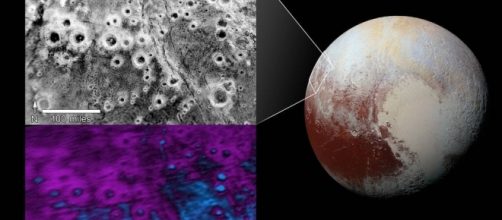Pluto continues to be the focus of worldwide attention. This time mission scientist at the National Aeronautics and Space Administration have used the close up images of the Dwarf Planet to create “flyover movies” of its landscape. The close-up images were obtained not too long ago in a historic flight through Pluto using NASA’s New Horizons spacecraft.
The Pluto system
According to a recent post on NASA’s website that was posted to mark a two-year anniversary of the Pluto flyby in July, the data gathered from that flight was currently still being analyzed.
The data includes high-quality global mapping of Pluto and the largest of the planet’s five moons, Charon. The other four are Styx, Nix, Kerberos, and Hydra.
Global maps of Pluto and Charon
From their geology to their satellite systems and atmosphere, we are facing the complexity of the Pluto system. Alan Stern, the principal investigator of New Horizons, has said of the new maps his team had created out of the exploration, “Everywhere we turn there are new mysteries.” Scientists are currently discussing the possibility of a return mission focusing on the changes that occur on the entire planet.
Since its discovery in 1930, Pluto has been and remains a mysterious point of light. NASA’s Virtual Tour of the system takes us on a flyover through Sputnik Planitia, or the nitrogen ice plain of the southwest region of Pluto.
From there we move toward the terrain of Cthulhu Macula, the fractured highlands of Voyager Terra, south to Pioneer Terra, ending at the ground of Tartarus Dorsa.
Another virtual tour, which can be accessed directly from NASA’s website, takes us around Charon, which was first discovered in 1978. We go over the moon’s canyons, through the deep and dark craters that begin on the hemisphere.
The flyby goes past Charon’s breathtaking landscape of Dorothy Gale, Mordor Macula, Oz Terra, and then ends at Clarke Montes. Pluto’s largest moon is only 1,214 kilometers in diameter.
A planet once more?
Other than mapping out the dwarf planet Pluto and its moons, scientists may be plotting to give Pluto back its planet status.
It lost the planethood status as it was demoted in 2006, when the International Astronomical Union (IAU) openly decided that Pluto was in fact not a planet. A group of scientists are now trying to reclassify Pluto as a “planet”, instead of its current “dwarf” status. According to Popular Science, the vital debate is akin to arguing over whether a hot dog is a sandwich or not.


